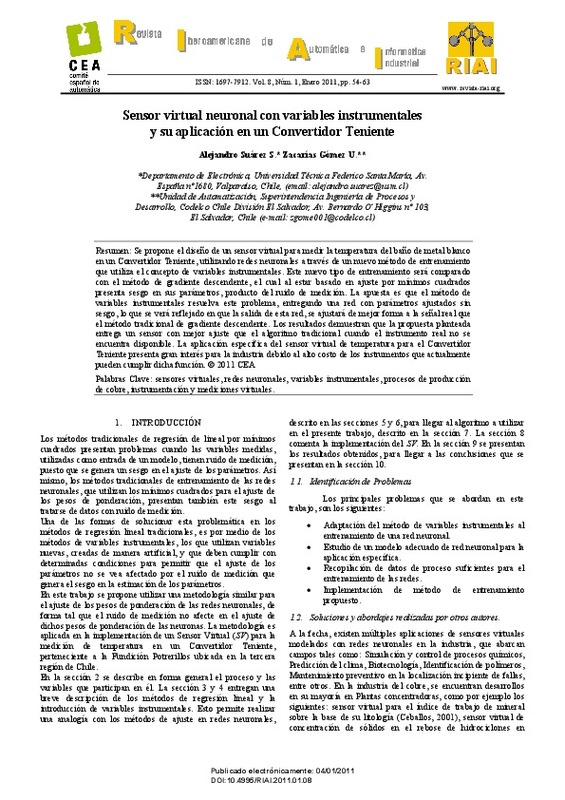JavaScript is disabled for your browser. Some features of this site may not work without it.
Buscar en RiuNet
Listar
Mi cuenta
Estadísticas
Ayuda RiuNet
Admin. UPV
Sensor virtual neuronal con variables instrumentales y su aplicación en un Convertidor Teniente
Mostrar el registro sencillo del ítem
Ficheros en el ítem
| dc.contributor.author | Suárez, Alejandro
|
es_ES |
| dc.contributor.author | Gómez U., Zacarías
|
es_ES |
| dc.date.accessioned | 2020-05-29T16:31:19Z | |
| dc.date.available | 2020-05-29T16:31:19Z | |
| dc.date.issued | 2011-01-04 | |
| dc.identifier.issn | 1697-7912 | |
| dc.identifier.uri | http://hdl.handle.net/10251/144664 | |
| dc.description.abstract | [EN] This article presents the proposition, software design and implementation of a virtual sensor, based on artificial neural networks trained with instrumental variables, to emulate and replace sensors in real copper mining company. These sensors real suffer from various shortcomings and failures that, given the amounts of the masses and volumes of material treated, incurred heavy losses to such companies. The virtual sensor proposed remedy, at low cost and in an optimal way, these shortcomings of the actual devices, ensuring product quality, reactors and other elements and at the same time improving the working conditions of staff. In addition, virtual sensors allow maintain a sustained line of information, independent of the availability of plant and operators.In the Codelco Company of Chile the largest fusion reactor, in the field of production of copper, is the 'Teniente Converter', design and patent Chilean, and the thesis is considered a implementation of the proposed virtual sensor to temperature measure in a Teniente Converter of the Salvador Division of the Company.The article provides an introduction to these processes of production of copper, a Vision on State of Art in measurements of the relevant variables and a description and Metallurgical Process 'Teniente Converter'. It is followed by a description of the implementation and Signals of interest to virtual sensing. It continues with Proposition Virtual Sensor, Algorithms and their training methods and the implementation of sensor. Evidence was presented with two models, the results and their analysis.It is concluded that the proposed and design virtual sensor allows remedy the shortcomings of the actual sensors and optimally improve the instrumentation, control and monitoring processes described, providing also sustained lines of information about them and other processes in the company. The primary contribution of the article lies in the design of the sensor virtual neural network trained with algorithms gradient with artificial variables and with two models. | es_ES |
| dc.description.abstract | [ES] Se propone el diseño de un sensor virtual para medir la temperatura del baño de metal blanco en un Convertidor Teniente, utilizando redes neuronales a través de un nuevo método de entrenamiento que utiliza el concepto de variables instrumentales. Este nuevo tipo de entrenamiento será comparado con el método de gradiente descendente, el cual al estar basado en ajuste por mínimos cuadrados presenta sesgo en sus parámetros, producto del ruido de medición. La apuesta es que el método de variables instrumentales resuelva este problema, entregando una red con parámetros ajustados sin sesgo, lo que se verá reflejado en que la salida de esta red, se ajustará de mejor forma a la señal real que el método tradicional de gradiente descendente. Los resultados demuestran que la propuesta planteada entrega un sensor con mejor ajuste que el algoritmo tradicional cuando el instrumento real no se encuentra disponible. La aplicación específica del sensor virtual de temperatura para el Convertidor Teniente presenta gran interés para la industria debido al alto costo de los instrumentos que actualmente pueden cumplir dicha función. | es_ES |
| dc.language | Español | es_ES |
| dc.publisher | Universitat Politècnica de València | es_ES |
| dc.relation.ispartof | Revista Iberoamericana de Automática e Informática industrial | es_ES |
| dc.rights | Reconocimiento - No comercial - Sin obra derivada (by-nc-nd) | es_ES |
| dc.subject | Virtual sensors | es_ES |
| dc.subject | Neural networks | es_ES |
| dc.subject | Instrumental variables | es_ES |
| dc.subject | Copper production processes | es_ES |
| dc.subject | Instrumentation and virtual measurements | es_ES |
| dc.subject | Sensores virtuales | es_ES |
| dc.subject | Redes neuronales | es_ES |
| dc.subject | Variables instrumentales | es_ES |
| dc.subject | Procesos de producción de cobre | es_ES |
| dc.subject | Instrumentación y mediciones virtuales | es_ES |
| dc.title | Sensor virtual neuronal con variables instrumentales y su aplicación en un Convertidor Teniente | es_ES |
| dc.title.alternative | Softsensor trained using the concept of instrumental variables and applied in the measurement of temperature in a Teniente Converter | es_ES |
| dc.type | Artículo | es_ES |
| dc.identifier.doi | 10.1016/S1697-7912(11)70008-5 | |
| dc.rights.accessRights | Abierto | es_ES |
| dc.description.bibliographicCitation | Suárez, A.; Gómez U., Z. (2011). Sensor virtual neuronal con variables instrumentales y su aplicación en un Convertidor Teniente. Revista Iberoamericana de Automática e Informática industrial. 8(1):54-63. https://doi.org/10.1016/S1697-7912(11)70008-5 | es_ES |
| dc.description.accrualMethod | OJS | es_ES |
| dc.relation.publisherversion | https://doi.org/10.1016/S1697-7912(11)70008-5 | es_ES |
| dc.description.upvformatpinicio | 54 | es_ES |
| dc.description.upvformatpfin | 63 | es_ES |
| dc.type.version | info:eu-repo/semantics/publishedVersion | es_ES |
| dc.description.volume | 8 | es_ES |
| dc.description.issue | 1 | es_ES |
| dc.identifier.eissn | 1697-7920 | |
| dc.relation.pasarela | OJS\8539 | es_ES |
| dc.description.references | Jain, P., Rahman, I., & Kulkarni, B. D. (2007). Development of a Soft Sensor for a Batch Distillation Column Using Support Vector Regression Techniques. Chemical Engineering Research and Design, 85(2), 283-287. doi:10.1205/cherd05026 | es_ES |
| dc.description.references | Solar M. (2000). Manual de Proceso del Convertidor Teniente CT5. “no publicado” | es_ES |









